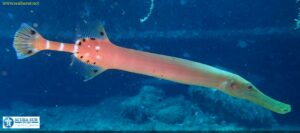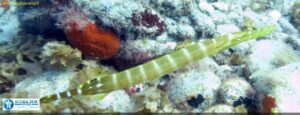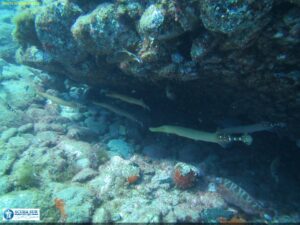Spotting the trumpetfish in Gran Canaria
Easy to recognise, often hanging in the water head down, long body, you will meet the Atlantic trumpetfish at any dive site in the south of Gran Canaria.

- How to recognize a trumpetfish?
- Scuba Diving
- The trumpetfish diet
- Good to know
- Some Science
- More Information
How to recognize a trumpetfish?
Trumpetfish are long bodied fish with an upward facing mouth at the end of a long tubular snout.
They have the ability to change colour, either to communicate their excitement or to camouflage them.

The most frequent colours recorded are brown or even blue, green or orange tones, or intermediate shades. They can display a pattern of pale, vertical and / or horizontal lines, or a dark mottling on the body. The dorsal and anal fins are semi-transparent with a black dot in front. Typically it has a pattern of four white spots on the body, between the dorsal and anal fins and three white vertical lines on its tail and black dots around its dorsal fin and tail.
It reaches a maximum length of 75 cm.
Scuba Diving
Trumpetfish are often found swimming head down along rock formations or sunken objects. When diving the Helena reef and the Arguineguin reef you will find a nursery of fish where they all gather, juveniles and adults, with a few hundreds together. Even in these big groups, they are no threat to scuba divers.

The trumpetfish diet
Its main prey is fish. You will often find them in small groups under other groups while hunting. It is not abnormal to find for example a group of sardines trapped between Trumpetfish below and Barracudas above.
When hunting smaller prey trumpetfish will hang vertically in the water column, head pointed downwards, striking at prey when the opportunity arises.
Good to know
They are capable of changing colours. They will employ their colour-changing abilities in the mating ritual as well as for camouflage.
Some Science
| Kingdom | Animalia |
| Phylum | Chordata |
| Class | Actinopterygii |
| Order | Syngnathiformes |
| Family | Aulostomidae |
| Genus | Aulostomus |
| Species | Aulostomus strigosus |
More Information
We get many questions about what there is to see when you go diving in the south of Gran Canaria. We want to respond to this by creating a number of articles where each highlights a specific species we regularly encounter when diving in the Atlantic. The complete series gives you a good idea of what to find when scuba diving in the blue waters of the south of Gran Canaria. Let’s be clear we are not marine biologists; just a dive centre trying to provide valuable information to our customers.
For the full details of the species we would like to refer to www.Wikipedia.com. Here you you’ll find more detail than we can go into.


